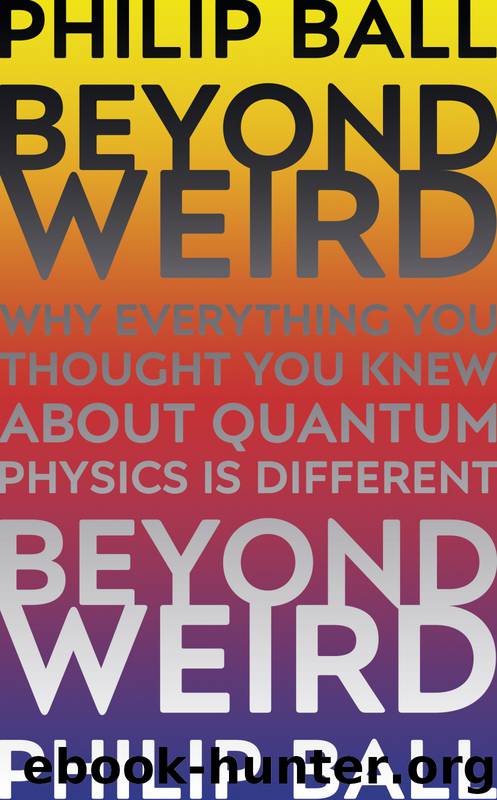Beyond Weird by Philip Ball

Author:Philip Ball
Language: eng
Format: epub, azw3
Publisher: Random House
I suggested earlier that the one thing ‘everyone knows’ about quantum mechanics is that the quantum world is fuzzy and uncertain. Actually there’s another thing too. ‘Everyone’ has heard of Schrödinger’s cat.
How seriously should we take Schrödinger’s cat?
Doubtless that’s why there are jokes about this idea too. Schrödinger is driving along when he is pulled over by a policeman. The officer looks over the car and asks Schrödinger if he has anything in the boot.
‘A cat,’ Schrödinger replies.
The policeman opens the boot and yells ‘Hey! This cat is dead!’
Schrödinger replies angrily, ‘Well, he is now.’
Don’t worry, I’m not going to pedantically pick this one apart too. As physics jokes go, it’s not so bad. At the least, it illustrates what a good job Schrödinger did in finding an image catchy enough to become a cultural meme.
Schrödinger’s aim was to demonstrate the paradox created if we try to divide the world into classical and quantum parts. What happens when the two can’t be so neatly separated?
But there are many uses for a cat, and Schrödinger wasn’t simply illustrating the problem of having one rule for the big and another for the very small. He wanted to demonstrate the apparent logical absurdity of quantum mechanics, in which mutually contradictory or exclusive circumstances – such as live and dead – coexist.
One might say that Schrödinger’s metaphor was too successful. The cat is still hauled out today as if to imply that we’re as puzzled as ever by the mere fact that the quantum world at small scales turns into the world of classical physics at human scales. The fact is, however, that this so-called ‘quantum–classical transition’ is now largely understood. Things have moved on, and we can state much more precisely than could Schrödinger and his contemporaries why and how quantum becomes classical. The answer is both elegant and rather astonishing.
For quantum physics is not replaced by another sort of physics at large scales. It actually gives rise to classical physics. Our everyday, commonsense reality is, in this view, simply what quantum mechanics looks like when you’re six feet tall. You might say that it is quantum all the way up.
The question, then, is not why the quantum world is ‘weird’, but why ours doesn’t look like that too.
In Schrödinger’s day it seemed fanciful to imagine that we could ever have a direct window onto the borderland between the microscopic and the macroscopic. It seemed even less likely that we could assert any control over that liminal region. So it was acceptable to pretend that this boundary was absolute, even if its location was somewhat hazy and open to debate. The quantum–classical transition is then like an ocean crossing between two continents: drawing a border somewhere in the open sea is an arbitrary exercise, but the continents are undeniably distinct. The land of the quantum, said Schrödinger, is random and unpredictable, yet the classical realm is orderly and deterministic because it depends only on statistical regularities among that atomic-scale chaos.fn1
Yet we are no
Download
This site does not store any files on its server. We only index and link to content provided by other sites. Please contact the content providers to delete copyright contents if any and email us, we'll remove relevant links or contents immediately.
The Complete Stick Figure Physics Tutorials by Allen Sarah(7135)
Secrets of Antigravity Propulsion: Tesla, UFOs, and Classified Aerospace Technology by Ph.D. Paul A. Laviolette(4984)
Thing Explainer by Randall Munroe(3782)
The River of Consciousness by Oliver Sacks(3414)
The Order of Time by Carlo Rovelli(3073)
How To by Randall Munroe(2912)
I Live in the Future & Here's How It Works by Nick Bilton(2844)
A Brief History of Time by Stephen Hawking(2819)
What If?: Serious Scientific Answers to Absurd Hypothetical Questions by Randall Munroe(2542)
The Great Unknown by Marcus du Sautoy(2535)
Midnight in Chernobyl by Adam Higginbotham(2388)
Blockchain: Ultimate Step By Step Guide To Understanding Blockchain Technology, Bitcoin Creation, and the future of Money (Novice to Expert) by Keizer Söze(2379)
Networks: An Introduction by Newman Mark(2264)
The Meaning of it All by Richard Feynman(2213)
Easy Electronics by Charles Platt(2207)
The Tao of Physics by Fritjof Capra(2164)
Midnight in Chernobyl: The Untold Story of the World's Greatest Nuclear Disaster by Adam Higginbotham(2077)
When by Daniel H Pink(2021)
Introducing Relativity by Bruce Bassett(2018)
